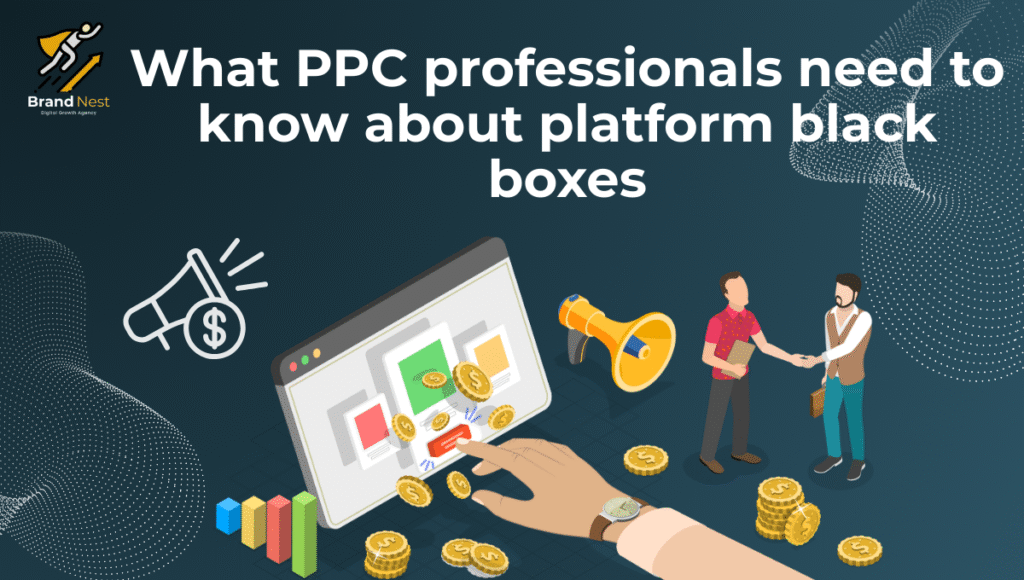
Pay-per-click (PPC) advertising has come a long way. Today, platforms like Google Ads, Facebook Ads, and Amazon Ads are more advanced than ever. They use machine learning, automated bidding, and AI-driven targeting to help advertisers reach the right audience.
However, with all these smart features comes a challenge — the “black box” problem.
In PPC, a black box is when a platform hides exactly how its systems make decisions. You give it your budget, set your goals, and it delivers results — but you can’t clearly see why or how those results happen. This can feel like you’re driving a car without being able to look under the hood.
Let’s break down what this means for PPC professionals, why it matters, and how to deal with it.
1. What Exactly is a “Black Box” in PPC?
A black box is a system where you can see the input (your ad settings, budget, targeting) and the output (clicks, conversions, impressions) but not the process in between.
For example:
You tell Google Ads to use “Maximize Conversions” bidding.
You give it your budget and targeting.
The platform shows your ads in certain places, to certain people, at certain times.
You see the final results, but you don’t know exactly why it chose those placements or bids.
Platforms do this partly to protect their algorithms and prevent abuse, and partly because the systems are too complex for manual interpretation.
2. Why Black Boxes Are Becoming More Common
There are three main reasons PPC platforms are turning into black boxes:
a) AI and Automation
Machine learning algorithms decide which ads to show, who sees them, and what you pay. These algorithms are often proprietary and can’t be fully explained.
b) Privacy Rules
With stricter privacy laws (like GDPR and Apple’s App Tracking Transparency), platforms limit how much audience data they reveal to advertisers.
c) Competitive Advantage
Platforms keep their bidding and targeting secrets to maintain a competitive edge and prevent advertisers from “gaming” the system.
3. The Risks of Black Box Advertising
While automation can save time and improve performance, black boxes also bring challenges:
a) Loss of Control
When you don’t see the decision-making process, it’s harder to make informed changes or troubleshoot problems.
b) Data Blind Spots
You may not know which exact keywords, placements, or audiences are driving your results — making optimization tricky.
c) Over-reliance on Automation
If you let the platform do everything, you risk becoming dependent and losing valuable manual skills.
d) Budget Waste
Without full transparency, there’s a risk your budget might be spent on placements or audiences you wouldn’t have chosen.
4. How PPC Professionals Can Work with Black Boxes
While we can’t open these black boxes completely, we can still manage them smartly.
a) Focus on Inputs You Can Control
Even if you can’t see the exact decisions, you can influence the outcome by:
Writing high-quality ad copy.
Choosing the right campaign objectives.
Setting realistic budgets.
Feeding the system accurate conversion data.
Think of it like baking — you may not see every step inside the oven, but the ingredients you choose matter.
b) Use Available Data Wisely
Platforms still provide reports — maybe not as detailed as before, but still valuable. Look for:
Search term reports (where available).
Placement performance (for display/video ads).
Geographic and device data.
This helps you spot trends even if the “why” is hidden.
c) Test and Compare
Don’t just rely on one campaign setup. Run A/B tests to see what works best. If you can’t see the exact process, compare the outputs of different strategies.
Example: Test “Maximize Conversions” bidding against “Manual CPC” to see which gives a better cost per lead.
d) Keep Learning New Tools
PPC is evolving quickly. Stay updated with new features, reporting tools, and third-party analytics that can fill in some of the data gaps.
5. The Human Advantage
It’s easy to feel like automation will replace PPC specialists, but that’s not true. Platforms may run the auctions and targeting, but humans bring:
Strategic thinking (deciding where and when to invest).
Creative skills (writing ad copy and designing visuals).
Business context (knowing the client’s goals and industry trends).
Remember: Machines optimize for clicks and conversions — humans optimize for business success.
6. Practical Tips to Thrive in a Black Box World
Here’s a quick checklist:
Feed the algorithm clean data — accurate tracking and conversion tagging.
Don’t ignore manual insights — your customer knowledge is still valuable.
Monitor closely — watch for sudden performance changes.
Experiment often — use tests to see what works without needing all the “why” details.
Educate clients/stakeholders — explain why full transparency isn’t possible and how you still manage performance.
7. Looking Ahead
The trend toward automation and reduced transparency will likely continue. Future PPC management will be less about micromanaging bids and more about:
Setting the right goals.
Providing the right data.
Interpreting results for business decisions.
PPC pros who adapt to this shift — embracing automation while staying analytical — will have an edge.
Final Thought
Black boxes in PPC can be frustrating, but they’re not going away. Instead of fighting them, smart advertisers learn how to work with them. By focusing on the parts you can control, running smart tests, and combining machine efficiency with human strategy, you can still achieve strong, measurable results.
In other words: You may not see everything inside the box — but you can still shape what comes out of it.


